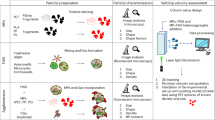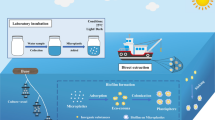Abstract
Microcystis colonies can overwinter in sediment and may inoculate the water column through recruitment, promoting the annual recurrence of Microcystis blooms. Through microcosm experiments, the survivability of benthic Microcystis was quantitatively investigated by elucidating the dynamics of its cell numbers, photosynthetic activity, and toxin content under various sediment conditions. The abundance of Microcystis colonies in the sediment samples did not decrease significantly over the 22-week experiment at 5 °C, whereas more than 90% of the benthic population died within 3 months at 25 °C. The survivability of the Microcystis colonies under the aerobic conditions of surface sediments was significantly lower than under the anaerobic conditions of deep sediments. Toxic M. aeruginosa and non-toxic M. wesenbergii exhibited similar survivability, although the final survival efficiency of M. aeruginosa was higher than that of M. wesenbergii at 15 and 25 °C. Microcystin quotas remained stable at 5 and 15 °C but decreased significantly at 25 °C. The photosynthetic activity of the benthic Microcystis colonies decreased gradually, with a larger decline rate at higher temperatures. Our study suggests that most benthic Microcystis colonies can overwinter successfully, with microcystins preserved and photosynthetic activity maintained, significantly increasing the risk of bloom formation. However, they were unable to accumulate in the sediments of subtropical shallow lakes over a period of years.





Similar content being viewed by others
References
Andrade ACS (2001) The effect of moisture content and temperature on the longevity of heart of palm seeds (Euterpe edulis). Seed Sci Technol 29:171–182
Boström B, Pettersson AK, Ahlgren I (1989) Seasonal dynamics of a cyanobacteria-dominated microbial community in surface sediments of a shallow, eutrophic lake. Aquat Sci 51:153–178
Brunberg AK (1999) Contribution of bacteria in the mucilage of Microcystis spp (Cyanobacteria) to benthic and pelagic bacterial production in a hypereutrophic lake. FEMS Microbiol Ecol 29:13–22
Brunberg AK, Blomqvist P (2002) Benthic overwintering of Microcystis colonies under different environmental conditions. J Plankton Res 24:1247–1252
Chaffin JD, Sigler V, Bridgeman TB (2014) Connecting the blooms: tracking and establishing the origin of the record-breaking Lake Erie Microcystis bloom of 2011 using DGGE. Aquat Microb Ecol 73:29–39
Cires S, Wormer L, Agha R, Quesada A (2013) Overwintering populations of Anabaena, Aphanizomenon and Microcystis as potential inocula for summer blooms. J Plankton Res 35:1254–1266
Ihle T, Jähnichen S, Benndorf J (2005) Wax and wane of Microcystis (Cyanophyceae) and microcystins in lake sediments: a case study in Quitzdorf Reservoir (Germany). J Phycol 41:479–488
Jørgensen BB, Cohen Y, Revsbech NP (1988) Photosynthetic potential and light-dependent oxygen consumption in a benthic cyanobacterial mat. Appl Environ Microb 54:176–182
Kasai F, Kawachi M, Erata M, Watanabe M (2004) NIES-collection: list of strains. Microalgae and protozoa, 7th edition. National Institute for Environmental Studies: pp 49–58
Latour D, Sabido O, Salencon MJ, Giraudet H (2004) Dynamics and metabolic activity of the benthic cyanobacterium Microcystis aeruginosa in the Grangent reservoir (France). J Plankton Res 26:719–726
Latour D, Salençon MJ, Reyss JL, Giraudet H (2007) Sedimentary imprint of Microcystis aeruginosa (cyanobacteria) blooms in Grangent Reservoir (Loire, France). J Phycol 43:417–425
Misson B, Donnadieu-Bernard F, Godon JJ, Amblard C, Latour D (2012a) Short- and long-term dynamics of the toxic potential and genotypic structure in benthic populations of Microcystis. Water Res 46:1438–1446
Misson B, Sabart M, Amblard C, Latour D (2012b) Benthic survival of Microcystis: long-term viability and ability to transcribe microcystin genes. Harmful Algae 13:20–25
Mohamed ZA, El-Sharouny HM, Ali WSM (2006) Microcystin production in benthic mats of cyanobacteria in the Nile River and irrigation canals, Egypt. Toxicon 47:584–590
Richardson LL, Castenholz RW (1987) Enhanced survival of the cyanobacterium Oscillatoria terebriformis in darkness under anaerobic conditions. Appl Environ Microb 53:2151–2158
Rinta-Kanto M, Saxton A, DeBruyn M, Smith L, Marvin H, Krieger A, Sayler S, Boyer L, Wilhelm W (2009) The diversity and distribution of toxigenic Microcystis spp. in present day and archived pelagic and sediment samples from Lake Erie. Harmful Algae 8:385–394
Sabart M, Misson B, Jobard M, Bronner G, Donnadieu-Bernard F, Duffaud E, Salencon MJ, Amblard C, Latour D (2014) Genetic diversity along the life cycle of the cyanobacterium Microcystis: highlight on the complexity of benthic and planktonic interactions. Environ Microbiol 17:901–911
Schöne K, Jähnichen S, Ihle T, Ludwig F, Benndorf J (2010) Arriving in better shape: benthic Microcystis as inoculum for pelagic growth. Harmful Algae 9:494–503
Schatz D, Keren Y, Vardi A, Sukenik A, Carmeli S, Börner T, Dittmann E, Kaplan A (2007) Towards clarification of the biological role of microcystins, a family of cyanobacterial toxins. Environ Microbiol 9:965–970
Tan W, Liu Y, Wu Z, Lin S, Yu G, Yu B, Li R (2010) cpcBA-IGS as an effective marker to characterize Microcystis wesenbergii (Komárek) Komárek in Kondrateva (cyanobacteria). Harmful Algae 9(6):607–612
Tian CC, Wang CB, Tian YY, Wu XQ, Xiao BD (2015) Root radial oxygen loss and the effects on rhizosphere microarea of two submerged plants. Pol J Environ Stud 24:1795–1802
Tsujimura S, Tsukada H, Nakahara H, Nakajima T, Nishino M (2000) Seasonal variations of Microcystis populations in sediments of Lake Biwa, Japan. Hydrobiologia 434:183–192
Verspagen JMH, Snelder EOFM, Visser PM, Huisman J, Mur LR, Ibelings BW (2004) Recruitment of benthic Microcystis (Cyanophyceae) to the water column: internal buoyancy changes or resuspension? J Phycol 40:260–270
Verspagen JMH, Snelder EOFM, Visser PM, Johnk KD, Ibelings BW, Mur LR, Huisman J (2005) Benthic-pelagic coupling in the population dynamics of the harmful cyanobacterium Microcystis. Freshw Biol 50:854–867
Wang C, Wu X, Tian C, Li Q, Tian Y, Feng B, Xiao B (2015) A quantitative protocol for rapid analysis of cell density and size distribution of pelagic and benthic Microcystis colonies by FlowCAM. J Appl Phycol 27:711–720
Wang Z, Li D, Cao X, Song C, Zhou Y (2014) Photosynthetic adaptation mechanism of Microcystis (Cyanophyceae) related to changes of colony size in a eutrophic lake. Phycologia 53:552–560
Wu X, Wang C, Tian C, Xiao B, Song L (2015) Evaluation of the potential of anoxic biodegradation of intracellular and dissolved microcystins in lake sediments. J Hazard Mater 286C:395–401
Wu X, Xiao B, Li R, Wang Z, Chen X, Chen X (2009) Rapid quantification of total microcystins in cyanobacterial samples by periodate-permanganate oxidation and reversed-phase liquid chromatography. Anal Chim Acta 651:241–247
Acknowledgments
This work was supported by the National Natural Science Foundation of China (31270509 and 31370504), the Joint NSFC-ISF Research Program (41561144008), the Major Science and Technology Program for Water Pollution Control and Treatment (2013ZX07102005), and the State Key Laboratory of Freshwater Ecology and Biotechnology of China (2016FB10). The authors are indebted to all members of the Harmful Algae team, especially Prof. Renhui Li of the Institute of Hydrobiology, CAS, for their help with the pure cultures of Microcystis strains and with instrumentation. We would also like to express our deepest thanks to Dr. Yuan Xiao (Analysis and Test Center, Institute of Hydrobiology, CAS) for instrumental support.
Author information
Authors and Affiliations
Corresponding author
Electronic supplementary material
ESM 1
(DOCX 26 kb)
Rights and permissions
About this article
Cite this article
Wang, C., Feng, B., Tian, C. et al. Quantitative study on the survivability of Microcystis colonies in lake sediments. J Appl Phycol 30, 495–506 (2018). https://doi.org/10.1007/s10811-017-1246-8
Received:
Revised:
Accepted:
Published:
Issue Date:
DOI: https://doi.org/10.1007/s10811-017-1246-8




